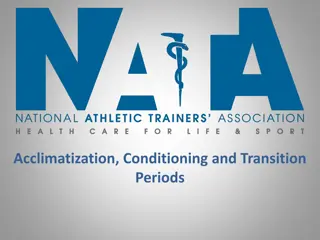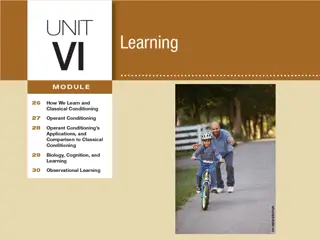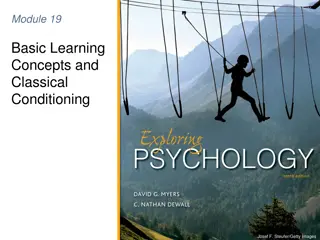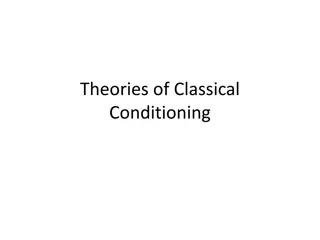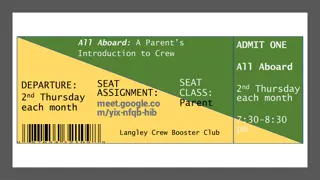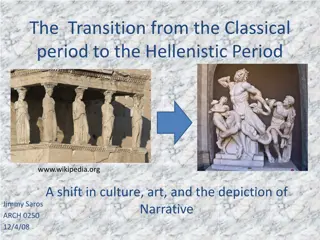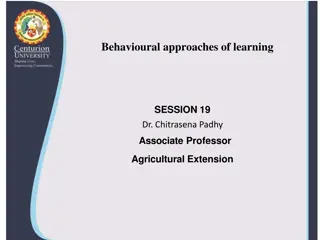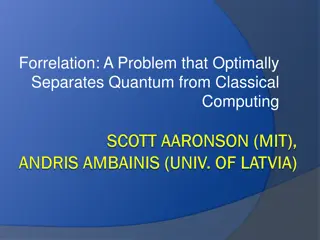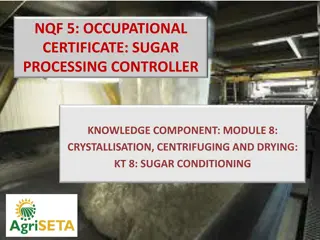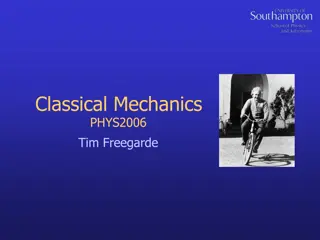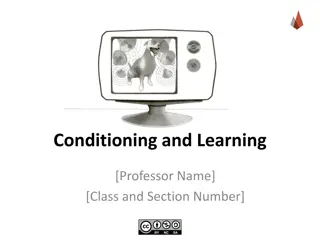Understanding Classical Conditioning Principles
Classical conditioning is a learning process where associations are formed between stimuli, resulting in behavioral changes. Pavlov's experiment with dogs illustrates this concept, involving neutral and unconditioned stimuli triggering responses. Learning occurs gradually during acquisition, with generalization and discrimination playing key roles. Extinction and spontaneous recovery demonstrate the fading and reappearance of conditioned responses over time.
Download Presentation

Please find below an Image/Link to download the presentation.
The content on the website is provided AS IS for your information and personal use only. It may not be sold, licensed, or shared on other websites without obtaining consent from the author. Download presentation by click this link. If you encounter any issues during the download, it is possible that the publisher has removed the file from their server.
E N D
Presentation Transcript
CHAPTER 9: LEARNING PRINCIPLES AND APPLICATIONS
SECTION 1: CLASSICAL CONDITIONING
LEARNING Def: a relatively permanent change in behavior that results from experience Classical Conditioning: learning procedure in which associations are made btwn a natural stimulus and a neutral stimulus
CLASSICAL CONDITIONING Neutral stimulus: a stimulus that does not initially elicit a response (bell) Unconditioned stimulus (UCS): an event that elicits a certain predictable response without previous training (food)
CC CONTINUED Unconditioned response (UCR): an organism s automatic/natural reaction to a stimulus (salivate) Conditioned stimulus (CS): a once-neutral event that elicits a given response after a period of training in which it has been paired with an UCS Conditioned response (CR): learned response to a CS
GENERAL PRINCIPLES OF CLASSICAL CONDITIONING
ACQUISITION Learning the response to a CS Occurs gradually Timing of association btwn CS and UCS influence learning Most effective when CS is presented right before UCS
GENERALIZATION AND DISCRIMINATION Generalization: responding similarly to a range of similar stimuli Discrimination: the ability to respond differently to similar but distinct stimuli Complementary processes
EXTINCTION AND SPONTANEOUS RECOVERY Extinction: the gradual disappearance of a CR when the CS is repeatedly presented without the UCS Spontaneous recovery: when the CR reappears when the CS is presented but not followed by a UCS, after a period of extinction
EXAMPLES OF CC Little Albert Bell and Pad to train bedwetters Taste aversion
REASON FOR CC Helps us predict---useful for survival Perfect example of behaviorist theory Shows how learners respond to their environment
SECTION 2: OPERANT CONDITIONING
WHAT IS IT? Def: learning in which a certain action is reinforced or punished, resulting in corresponding increases or decreases in occurrence The study of how voluntary behavior is affected by consequences
REINFORCEMENT B.F. Skinner Believed actions are based on history of reward and punishment Trained rats Reinforcement: stimulus or event that follows a response and increases the likelihood that the response will be repeated
TYPES OF REINFORCEMENT Positive reinforcement: something that is added after an action Negative reinforcement: something unpleasant taken away after an action
REINFORCERS Primary reinforcer: stimulus that is naturally rewarding, such as food or water Secondary reinforcer: stimulus such as money that becomes rewarding through its link with a primary reinforcer
SCHEDULES OF REINFORCEMENT Continuous reinforcement: reinforce every response Partial reinforcement: intermittent reinforcing produces more stable and longer lasting
PARTIAL REINFORCEMENT Four basic schedules based on: Ratio numberof correct responses btwn reinforcements Interval amount of timeelapsed before reinforcement is given Fixed predictable Variable--unpredictable
SCHEDULES OF REINFORCEMENT Fixed-ratio schedule: a specific number of correct responses is required before reinforcement can be obtained Variable-ratio schedule: an unpredictable number of responses are required before reinforcement
SCHEDULES CONTINUED Fixed-interval schedule: a specific amount of time must elapse before a response will elicit reinforcement Variable-interval schedule: changing amounts of time must elapse before a response will obtain reinforcement
SHAPING Shaping: technique in which the desired behavior is molded by 1strewarding any act similar to that behavior and then requiring ever- closer approximations to the desired behavior before giving the reward
CHAINING Response chain: learned reactions that follow on another in sequence, each reaction producing the signal for the next Learning smaller skills to obtain a larger skill
AVERSIVE CONTROL Def: process of influencing behavior by means of unpleasant stimuli 2 ways: negative reinforcement or punishers
NEGATIVE REINFORCEMENT Def: increasing the strength of a given response by removing or preventing a painful stimulus when the response occurs 2 uses: escape conditioning and avoidance conditioning
ESCAPE CONDITIONING Def: training of an organism to remove or terminate an unpleasant stimulus
AVOIDANCE CONDITIONING Def: training of an organism to withdraw from or prevent an unpleasant stimulus before it starts
PUNISHMENT Meant to decrease an undesired behavior Punishment may be what a child wants It could reinforce a need for attention
DISADVANTAGES OF PUNISHMENT Could produce unwanted side effects Rage, aggression, fear People learn to avoid the person delivering the punishment Does not teach acceptable behavior Positive coaching and modeling are needed
SECTION 3: SOCIAL LEARNING
SOCIAL LEARNING Def: process of altering behavior by observing and imitating the behavior of others 2 types: cognitive learning and modeling
COGNITIVE LEARNING Def: form of altering behavior that involves mental processes and may result from observation and imitation Ex: latent learning and learned helplessness
COGNITIVE MAPS Def: a mental picture of spatial relationships or relationships between events Introduced by Edward Tolman in the 1930s Rat maze
LATENT LEARNING Def: alteration of a behavioral tendency that is not demonstrated by an immediate, observable change in behavior Occurs in the absence of a reinforcer
LEARNED HELPLESSNESS Def: condition in which repeated attempts to control a situation fail, resulting in the belief that the situation is uncontrollable Martin Seligman believes this is a root cause of depression
LEARNED HELPLESSNESS Seligman: 3 elements of LH 1) Temporary vs. stable: 2) Specific vs. Global 3) External vs. Internal:
MODELING Def: learning by imitating others; copying behavior 3 basic types of modeling: 1) behavior of others increases chances of you performing the behavior 2) Observational learning: mimicking 3) Disinhibition: observe someone engaged in dangerous activity without being punished, you will find it easier to engage in that behavior later
BEHAVIOR MODIFICATION Def: systematic application of learning principles to change people s actions and feelings Use classical conditioning to overcome fears Modeling to teach desired behaviors Operant conditioning applied to everyday problems
TOKEN ECONOMIES Token economy: conditioning in which desirable behavior is reinforced with valueless objects, which can be accumulated and exchanged for valued rewards
SELF-CONTROL Steps: 1) Define the problem 2) Set up a behavioral contract 3) Honestly self-monitor
IMPROVING STUDY HABITS Stop when feeling distracted Study in new areas Apply all 3 major learning styles (CC, OC, SL)




